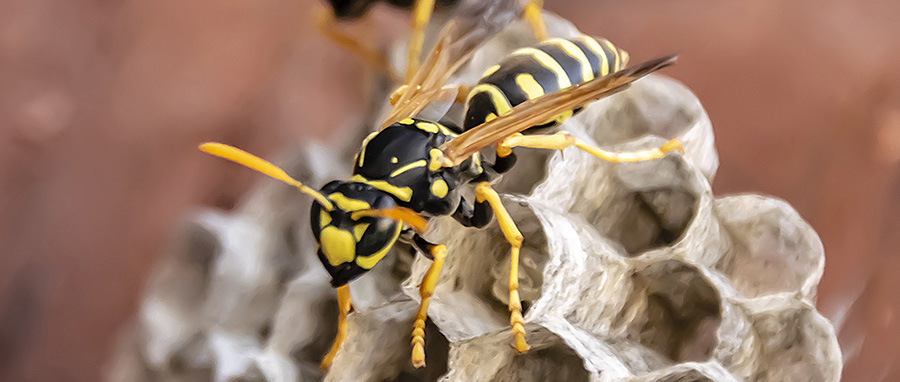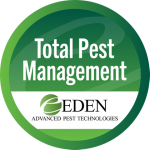Serving Spokane Metro | Coeur d’Alene ID | Post Falls ID | Tri-Cities WA
From bustling backyard barbecues to serene strolls through nature, encounters with wasps are an inevitable part of life in the Evergreen State. Knowing about the different types of wasps in our area can help you identify nests, avoid painful stings, and enjoy your time outdoors without worrying about a dangerous encounter with stinging insects.
Types of Wasps in your area
Here in eastern Washington, we’re no stranger to sunny days that are riddled with wasps buzzing around. Some of the most common types of wasps you’ll find around here include:
Bald Faced Hornet
Bald-faced hornets are large, black-colored wasps with distinct white markings on their faces and abdomens. They typically build large, football-shaped nests high in trees or on buildings. Bald-faced hornets are known for their aggressive behavior when their nests are threatened, making them a formidable presence for homeowners.
European Hornet
These hornets are larger than most native species, with a brownish-red body and yellow stripes. European hornets often nest in hollow trees, wall voids, or attics. While they can be less aggressive than other species, European hornets will defend their nests vigorously if provoked.
Mud Dauber
Mud daubers are solitary insects known for their distinctive nests made from mud. They construct cylindrical mud tubes in sheltered locations, such as under eaves or inside garages. Mud daubers are not typically aggressive and primarily prey on spiders, making them beneficial for natural pest control.
Paper Wasp
Paper wasps are recognizable by their slender bodies and distinctive paper-like nests, hence their common name. These nests are often umbrella-shaped and attached to branches, eaves, or other structures. Paper wasps are generally less aggressive than some other species but will defend their nests if threatened.
Yellow Jacket
Yellow jackets are among the most common and aggressive wasps encountered in Washington. They are typically black and yellow in coloration and build nests underground, in wall voids, or in other protected locations. Yellow jackets are scavengers and can become a nuisance at outdoor gatherings, where they are attracted to sweet foods and meats.
Do You Have Bees or Wasps?
Bees are typically rounder and fuzzier in appearance compared to the sleek and slender build of wasps. Bees often have a plumper abdomen and are covered in fine hairs, giving them a softer appearance. In contrast, wasps are more streamlined, with a sleek body and minimal hair, if any.
Another way to distinguish between bees and wasps is by examining their nests. Bee nests are often constructed from wax, forming hexagonal cells that make up their familiar honeycomb structure. These nests are usually found in protected locations, such as tree hollows, wall voids, or specially built hives.
On the other hand, wasp nests vary in appearance depending on the species. Common wasps, such as yellow jackets and paper wasps, build papery nests from wood fibers and saliva. These nests may be suspended from eaves, tree branches, or tucked away in sheltered areas. If you find one, you should contact an exterminator right away.
Are Wasps More Dangerous Than Bees?
At first glance, wasps and bees might seem quite similar, both buzzing around with stingers at the ready. However, when it comes to assessing their danger, there’s a significant contrast. Wasps tend to be far more aggressive in their behavior and pose unique threats:
- Wasps are territorial: Wasps are inherently more territorial and confrontational creatures. While bees typically only sting when they feel directly threatened, wasps can become aggressive seemingly without provocation.
- Bees can only sting once: Unlike bees, which can only sting once before their stinger becomes lodged and they die, wasps possess the ability to sting multiple times. This means that encountering a single wasp can result in multiple painful stings.
- Wasps release pheromones when stinging: When a wasp feels threatened or is killed, it can release alarm pheromones, signaling nearby wasps to join the attack. This can quickly escalate into a stinging swarm, posing a significant danger to anyone in the vicinity.
How to Avoid a Wasp Sting
If wasps are invading your property, you stand a good chance of being stung. To these bad-tempered bugs, your property is now theirs. If wasps manage to get inside your home, they will pose an even greater risk to your safety.
The best thing to do if you have wasps is to steer clear and let a professional handle the job. Trying to remove a hornet’s nest yourself can lead to serious injury and unsuccessful extermination. Experts have the right tools and resources needed to safely eliminate the nest and keep your space sting-free.
Wasp removal services by Eden Advanced Pest Technologies employ high-tech tools that neutralize wasps and prevent their return. Call us today to learn more and to receive a free quote.
Back to Wasp Exterminators, Control & Removal

